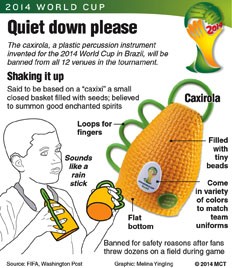There are many things an average FIFA World Cup fan will hear: the roar of the crowd, fans shouting their agreement and disagreement in seemingly indistinguishable languages, the crunch of cleats on grass, sports commentators detailing every move of the players and the instruments of the World Cup.
The vuvuzela was more than just a plastic trumpet representing the 2010 World Cup in South Africa. It has been banned from countless sporting games, including the World Cup, and The Guardian pronounced it the most annoying sporting event noisemaker in the known universe.
“[The vuvuzela won] over inflatable plastic sticks, ‘Sweet Caroline’, air horns, that one guy who can be heard four sections away screaming epithets at the refs and the occasional trumpet,” Megan Carpentier wrote in The Guardian.
The vuvuzela’s obnoxious and overwhelming buzzing caused hearing damage and made it insurmountably more difficult for sports journalists to report directly from the game – something especially important because most fans couldn’t make it to the stadiums in South Africa.
The infamous and deafening buzz of the vuvuzela drew attention to fans of the South African 2010 World Cup. This year, musician Carlinhos Brown created something new: the caxirola. Brown is a Brazilian musician, songwriter and record producer who contributed music to the movie “Rio.” His genre is Tropicalia and reggae, and he has been known to blend in traditional Brazilian percussion, making him the perfect candidate to create the instrument for the Brazilian World Cup.
Brazil’s Ministry of Sport thought they had made a safe choice with the caxirola for the 2014 World Cup. It isn’t too loud, and it appeared to be a fun, recyclable moneymaker. It’s sort of like a handheld rainstick with finger holes so that the user can buy a pair and clap them together. The noise of the caxirola is much more appealing than that of the vuvuzela, although that isn’t a huge feat.
But when fans began hurling them towards referees, the long list of items banned from the World Cup by Brazil’s Ministry of Justice became longer: outside food and drinks, fireworks, megaphones, large flags and banners, vuvuzelas, and now caxirolas.
Why does the World Cup have such bad luck making musical instruments readily available for its fans? Maybe it is because fans of arguably the biggest game in the world tend to get a little hot and heated, leading to misuse of the instruments.
The caxirola may not be a big part of the atmosphere in the stadium, but the Irish Times suspects that it is not the last you will hear of the handheld rainstick.
“They are sure to be heard throughout Fan Fests and popular gatherings as the World Cup kicks off,” the Irish Times said.
While the hype of the vuvuzela is obviously larger than that of its successor, one thing can be certain: the 2014 World Cup will not be silent.









